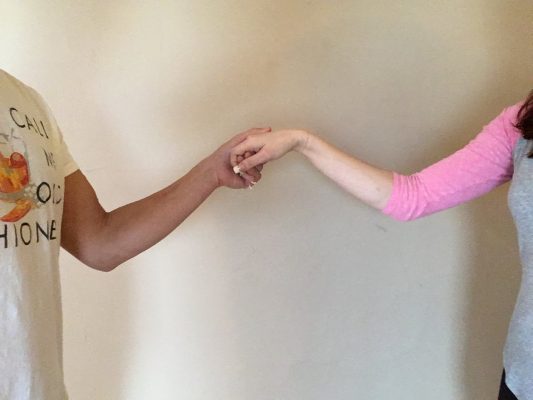One of the most common questions dancers ask is “How to improve your connection in west coast swing.” At a basic level improving your connection in west coast swing is about the relationship between your center and your partners center. Advanced dancers, are able to move around their hands while still maintaining the energy of the center-to-center connection. Let’s figure out how to improve your connection the right way, for you!
If you’re completely unfamiliar with connection and lead & follow in west coast swing, you’ll want to check out our post intro to connection. Either way these 3 tips will dramatically improve your connection in WCS.
TAKE ACTION> Download this video! Everything you need to know about connection
3 ways to Improve you Connection in West Coast Swing
1. Isolate your connection point (center separation)
When styling, many dancers drag their connection point with them, pulling their partners off balance or undermining their frame. Excellent dancers, by contrast, know how to dance so their partners can feel their styling, without moving their point of connection.
The skill of moving without affecting the connection is sometimes referred to as “center separation” or “center isolation.” Your body or center is being moved in isolation from the connection. Developing the skill of moving your body without affecting the connection point will dramatically improve your WCS connection!
In this video we explain how to isolate your connection point to allow you body to stay free for own styling.
Do this drill alone: By yourself, stand next to a wall. Make a fist and put your fist against the wall, roughly between your waistline and your belly button.Your goal is to leave that connection point unaffected. As you start, focus on simply not moving the hand. When you master that skill, increase the difficulty level by keeping the amount of connection with your partner, or in this case the wall, constant.
Progress into doing any body isolations, footwork, arm styling, or any other motion that you might use in your WCS. If you need ideas to start, practice doing triple variations.
Make sure that you aren’t moving your hand! Use your wrist, elbow, and shoulder in order to isolate the body’s motion from your hand’s connection point.
2. Keep your connection low
The WCS connection is relaxed. Even during the crazy patterns, the pros’ bodies may be flying but their connection won’t show the tension. We need to work on bringing that relaxed look to our dance.
In the default hand connection, the partners are connected with their arms like telephone wires. The shoulder of each partner is the highest point on the arc, and the arms should rest at the bottom of the arc. If the partners move further away, the hands will rise, but if they move closer together the hands will lower further. Just like a telephone wire does not lift itself up in between the posts, the WCS hand connection should not lift itself between the partners.
Your arms should never end up in a “W” position, where the hands are above the elbows! (Especially when in compression in a sugar push)
Good example of hand position
The dreaded ‘W’ look we are trying to avoid
Most dancers carry some degree of tension in their arms, and the result is to destroy this telephone pole analogy. By engaging the arm muscles, not only do the hands rise (which makes the connection look stiff)—the connection itself suffers because the arm muscles get in the way of the center-to-center connection.
The Drill: With a partner, practice simple side passes (with no turns). Focus on relaxing the arms so that they drop naturally as the partners pass and rise naturally as the move away. The rising action should happen without any effort; simply because of the increased distance, the hands will move up just like a telephone wire will stay higher if the poles are separated.
Your arms should never end up in a “W” position, where the hands are above the elbows. If that occurs, reset and try again.
3. Keep your hands still
Many beginning dancers accidentally add noise to their connection by moving their hands around. They may be keeping time by moving their hands on the beat or they may simply be unaware of how their hand is moving because they are focused on other parts of their body. In either case, the end result is the same—lots of unnecessary movement that is transmitted through the hand connection to their partner.
Practice calming your hands while you dance so your connection isn’t filled with noise and distractions.
A fun drill: Put a coin on your hand as you stand in a normal dance position. By yourself, dance through your basics and focus on keeping your hand from moving. If the coin falls off your hand, that’s a sign that your hand is too noisy!
Pay particular attention to what your hand does on the anchor. Many dancers conduct their hands on the anchor as if they were keeping time. They bounce, make figure 8 motions, etc. These habits can become deeply ingrained, so use this drill to keep your hands quiet on the anchor. You should still be able to create a good stretch by moving your center away without shifting your hand.
BONUS: Connection exiting turns
It’s very common for the hands to stay up after an outside turn (like a sugar tuck or a whip with an outside turn). Practice letting the hands relax as the follower finishes the turn so that both hands are low at the end.
TAKE ACTION> Read 3 turns you need to know for west coast swing
Leaders: do not push the hand lower, and make sure that the hand isn’t lowering before the follower is looking at you. Lowering the hand early can cause serious injury to the rotator cuff.
Followers: make sure that you stay close enough during the turn that you have the slack to lower the arm. If you feel like you can’t let the arm relax, you have probably overextended yourself on the turn.






 Brian & Megan
Brian & Megan